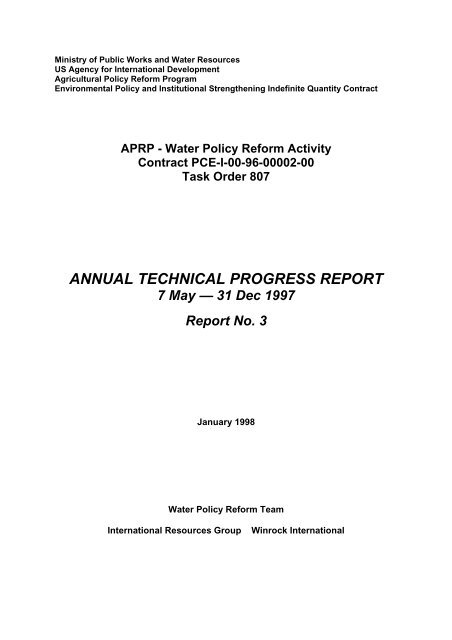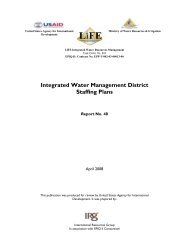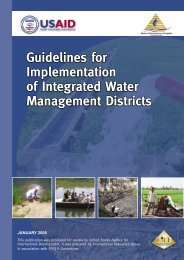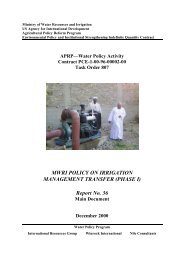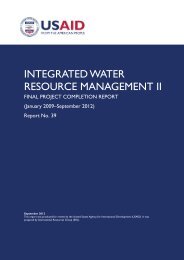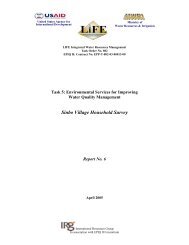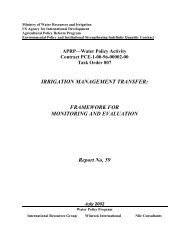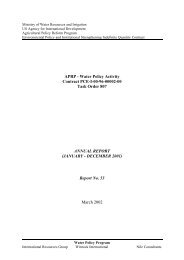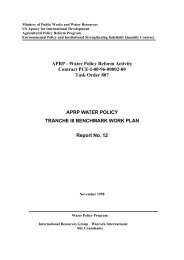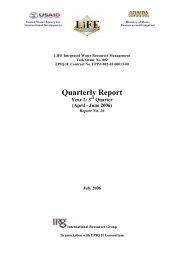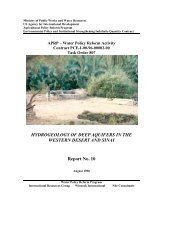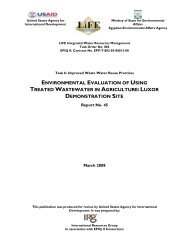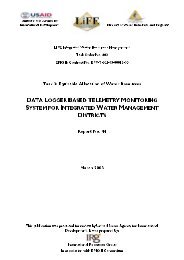APRP - Water Policy Reform - LIFE-IWRMII Project, Egypt
APRP - Water Policy Reform - LIFE-IWRMII Project, Egypt
APRP - Water Policy Reform - LIFE-IWRMII Project, Egypt
- No tags were found...
You also want an ePaper? Increase the reach of your titles
YUMPU automatically turns print PDFs into web optimized ePapers that Google loves.
Ministry of Public Works and <strong>Water</strong> ResourcesUS Agency for International DevelopmentAgricultural <strong>Policy</strong> <strong>Reform</strong> ProgramEnvironmental <strong>Policy</strong> and Institutional Strengthening Indefinite Quantity Contract<strong>APRP</strong> - <strong>Water</strong> <strong>Policy</strong> <strong>Reform</strong> ActivityContract PCE-I-00-96-00002-00Task Order 807ANNUAL TECHNICAL PROGRESS REPORT7 May — 31 Dec 1997Report No. 3January 1998<strong>Water</strong> <strong>Policy</strong> <strong>Reform</strong> TeamInternational Resources GroupWinrock International
TABLE OF CONTENTSI. Introduction 2II. <strong>Project</strong> Startup 5III. Mobilization 6IV. Technical Activities and Accomplishments (1 Jul - 30 Sep 1997) 7A. Tranche I Benchmark Review 7B. Tranche 2 Benchmarks 7C. <strong>Project</strong> Implementation Plan 7D. Other Activities 8E. Personnel 9V. Technical Activities and Accomplishments (1 Oct - 31 Dec 1997) 10A. Drainage <strong>Water</strong> Reuse 10B. National Strategy for Irrigation Improvements 12C. Management and Economic Factors Affecting Crop Choices 14D. Deep Groundwater 15E. WUAs in Non-IIP Areas 15F. Tranche I Benchmark Support 16G. Other Activities 16H. Personnel 17VI. Administrative Support 18VII. Financial Summary 20VIII. EPIQ <strong>Water</strong> <strong>Policy</strong> Team Reports and Publications 21Appendixes:Appendix 1: Agenda of <strong>Project</strong> Startup WorkshopAppendix 2: Summary of Long Term TAAppendix 3: Summary of Short Term TAAppendix 4: Tranche 2 Benchmarks and Background DocumentationAppendix 5: Agenda and Attendees at Port Said WorkshopAppendix 6: <strong>Project</strong> Implementation PlanAppendix 7: An Action Plan for Irrigation <strong>Water</strong> Cost SharingAppendix 8: Current Contents of EPIQ Team Library1
Annual Technical Progress Report(7 May 1997 – 31 December 1997)Agricultural <strong>Policy</strong> <strong>Reform</strong> <strong>Project</strong><strong>Water</strong> <strong>Policy</strong> <strong>Reform</strong> ActivityEnvironmental <strong>Policy</strong> and Institutional Strengthening Indefinite Quantity ContractUSAID Contract PCE-I-00-96-00002-00Task Order 807I. INTRODUCTION<strong>Egypt</strong>’s water resources, supplied almost exclusively from the Nile River, are underincreasing stress due to expanding irrigation needs, population growth and the concomitantexpansion in domestic water needs, and an increasing load of pollutants which is threateningthe <strong>Egypt</strong>ian environment and the health of its citizens. The Ministry of Public Works and<strong>Water</strong> Resources (MPWWR) is the primary <strong>Egypt</strong>ian governmental agency charged with themanagement of water resources. Keenly aware of the need to improve the utilizationefficiency and productivity of water resources in <strong>Egypt</strong>, the MPWWR and the US Agency forInternational Development (USAID) designed a “water resources results package” basedupon years of earlier joint experience in water resources management projects.The package has four major results: 1) improved irrigation policy assessment and planningprocess, 2) improved irrigation system management, 3) improved private sector participationin policy change, and 4) improved capacity to manage the policy process.USAID and the MPWWR designed the water resources results package based on a “nonproject”assistance approach aimed at policy analyses and reforms leading to improvedwater use efficiency and productivity. The MPWWR is responsible for various activitiesunder the four results. USAID supports the Ministry’s efforts through a cash transfer(tranche) mechanism based on performance of achieving identified and agreed upon policyreform benchmarks, and technically through a task order with an internationally recognizedorganization capable of providing technical analyses, supporting research and studies, etc.,to assist policy and institutional reforms in the first three results.Under the Environmental <strong>Policy</strong> and Institutional Strengthening Indefinite Quantity Contract(EPIQ) signed by USAID and a consortium headed by the International Resources Group(IRG), USAID/Cairo issued Task Order (TO) 807 effective May 7, 1997. The TO supportsthe <strong>Egypt</strong> Mission’s Agricultural <strong>Policy</strong> <strong>Reform</strong> Program (<strong>APRP</strong>), and is addressedparticularly at increasing “...the global efficiency and productivity of <strong>Egypt</strong>’s Nile <strong>Water</strong>System.” Specific objectives are:1. To increase Ministry of Public Works and <strong>Water</strong> Resources (MPWWR) knowledgeand capabilities to analyze and formulate strategies, policies and plans related tointegrated water supply augmentation, conservation and utilization, and to theprotection of the Nile water quality.2. To improve water allocation and distribution management policies for conservation ofwater while maintaining farm income.3. To recover the capital cost of mesqa improvement, and to establish a policy for therecovery of operation and maintenance costs of the main system.2
4. To increase users' involvement in system operation and management.5. To introduce a decentralized planning and decision making process at the irrigationdistrict level.The water resources results package is part of the USAID/<strong>Egypt</strong> Mission’s Agricultural <strong>Policy</strong><strong>Reform</strong> Program (<strong>APRP</strong>), a broad-based policy reform program housed in the Ministry ofAgriculture and Land Reclamation (MALR). <strong>APRP</strong> has the goal of developing andimplementing policy reform recommendations in support of private enterprise in agricultureand agribusiness. Several <strong>Egypt</strong>ian Government Ministries participate in <strong>APRP</strong>. Besidesthe MPWWR and the MALR, the Ministry of Trade and Supply, the Ministry of PublicEnterprises and the Ministry of International Cooperation also participate.The EPIQ <strong>Water</strong> <strong>Policy</strong> <strong>Reform</strong> Activity is one of five complementary activities of <strong>APRP</strong> inthe MPWWR aimed at achieving the goals and objectives of the water resources resultspackage. The EPIQ <strong>Water</strong> <strong>Policy</strong> <strong>Reform</strong> Unit and the MPWWR <strong>Water</strong> <strong>Policy</strong> Advisory Unit(WPAU) lead these activities. The MPWWR telemetry program and the Nile ForecastCenter provide key data and information in support of policy regarding system operation andmanagement. The <strong>Water</strong> Communication Unit focuses on strategies to promote policyreform and water conservation through public awareness and education. Each of theseactivities is housed in the MPWWR building in Imbaba.The EPIQ <strong>Water</strong> <strong>Policy</strong> <strong>Reform</strong> Activity was one of the last <strong>APRP</strong> units to assemble under<strong>APRP</strong>. In addition to collaborating with other MPWWR units, the EPIQ <strong>Water</strong> <strong>Policy</strong> Activityclosely coordinates with the <strong>APRP</strong> <strong>Project</strong> Management Unit; the <strong>Reform</strong> Design andImplementation Unit; the Monitoring, Evaluation and Verification Unit; and the Food SecurityResearch Unit all housed on the 15 th floor of the Companies Building of the MALR in Dokki.A team of <strong>Egypt</strong>ian and expatriate specialists, the EPIQ <strong>Water</strong> <strong>Policy</strong> <strong>Reform</strong> Team, hasbeen assembled within the framework of the EPIQ task order to assist the MPWWR inachieving policy and institutional reforms that arise from technical analysis of pertinent waterresource issues. Expatriate specialists have been identified and employed by WinrockInternational, sub-contractor to IRG on the EPIQ TO 807, as well as by IRG itself. <strong>Egypt</strong>ianspecialists are supplied by Nile Consultants, an <strong>Egypt</strong>ian water, environment and agriculturaldevelopment consulting firm, also through a sub-contract with IRG. The EPIQ <strong>Water</strong> <strong>Policy</strong>Team actively participates in weekly meetings of all <strong>APRP</strong> units to discuss on-goingactivities, problems and issues which may need joint action.The MPWWR has established a project steering committee to oversee, supervise andcoordinate project activities. The steering committee meets regularly and consists of seniorMPWWR officials, a representative of USAID and the technical assistance team leader.Organization of this ReportThis report provides a brief overview, in chronological order, of project activities from 7 May1997 (date of notice to proceed from the USAID Mission) through 31 December 1997. Theproject planning workshop, the composition of, and the mobilization of the long termtechnical assistance team are reviewed first. <strong>Project</strong> technical and management activitiesand accomplishments for the periods: 1 July through 30 September 1997 and 1 Octoberthrough 31 December 1997 are subsequently reviewed. <strong>Project</strong> administrative supportduring the period is outlined and project financial summaries for each quarter are provided.Supporting project documentation is included as appendixes to this progress report.3
II. PROJECT STARTUPWith the issuance of the Task Order (TO) 807 notice to proceed effective May 7, 1997 byUSAID/Cairo, International Resources Group (IRG) and Winrock International began formalpreparations for mobilizing the long term technical assistance (LTTA) team to <strong>Egypt</strong>. One ifthe first steps in this process was a Team Planning Meeting held in Washington DC, June 5-6, 1997. The agenda for this meeting is given in Appendix 1.This team planning meeting provided the first opportunity for the long term TA team toconvene, meet each other, meet key technical and administrative support personnel of IRGand Winrock, and briefly review the history and some of the technical activities behind thewater resources result package. In addition, the team had the opportunity to meet andbriefly discuss the water policy reform activity with key USAID personnel: Ken Baum, USAIDGlobal Environment Office, EPIQ <strong>Project</strong> Officer and COTR, Curt Nissley,USAID/Washington, EPIQ <strong>Project</strong> Co-COTR and Craig Anderson, USAID/Cairo, waterresources reform activity COTR.Listed below are the attendees of the EPIQ <strong>Egypt</strong> <strong>Water</strong> Resources Results Package TeamPlanning Meeting.Name Position AffiliationJohn Priest LTTA Team Leader Winrock Intl.Thomas Burola LTTA Administrative Officer IRGThomas Ley LTTA Senior Irrigation Engineer Winrock Intl.Dennis Wichelns LTTA Senior <strong>Water</strong> Economist Winrock Intl.Zhongping Zhu LTTA Senior <strong>Water</strong> Resources Engineer Winrock Intl.Michael Rock Senior Economist and <strong>Project</strong> Officer Winrock Intl.Douglas Clark EPIQ Coordinator IRGJack Keller Irrigation Engineer Keller-BliesnerEngineeringIan Fitzsimmons EPIQ <strong>Project</strong> Administrator IRGSinikka DeHanas <strong>Project</strong> Administrator Winrock Intl.Chris Kopp Program Officer Winrock Intl.Ken Baum EPIQ <strong>Project</strong> Officer USAID G/ENVWashingtonCurt Nissley <strong>Project</strong> Officer USAID G/ENVWashingtonCraig Anderson COTR USAID/CairoDonald Spears Facilitator MSI4
III. MOBILIZATIONThe EPIQ <strong>Water</strong> <strong>Policy</strong> long term expatriate technical assistance team mobilized to <strong>Egypt</strong>during June 1997. Mr. Thomas Burola, Administrative Officer, and family, arrived in Cairo onJune 12. Dr. Zhongping Zhu, Senior <strong>Water</strong> Resources Engineer, arrived in Cairo on June13. Mr. John Priest, Chief of Party, and his wife arrived June 18. Dr. Thomas Ley, SeniorIrrigation Engineer, and family, arrived on June 20. Dr. Dennis Wichelns, Senior <strong>Water</strong>Economist, arrived in Cairo on July 2. The expatriate LTTA team members were initiallyhoused in the Cairo Marriott Hotel. Team members individually sought long term livingaccommodations in various locations of Cairo. Most members of the team had foundapartments and entered into long term lease agreements by early August 1997.Transportation was arranged by the Administrative Officer through a local short term contractfor 3-4 vehicles and 3-4 drivers, depending upon needs. A vehicle was made available forthe Chief of Party, the Administrative Officer, and the remaining technical team members.Communications were facilitated by procurement and provision of cell phones for the Chiefof Party and the Administrative Officer.During the last few days of June and the first week of July, the long term TA team essentiallybegan technical operations and activities (described in the next section) from the MarriottHotel. Beginning July 7, the team temporarily occupied available office space in the NileConsultants offices located at 1/5 Street 216, Digla, Maadi. The team used these facilitiesas its headquarters until early October 1997, when it transferred into renovated office spaceon the 9 th floor of the MPWWR office building in Imbaba.Long term <strong>Egypt</strong>ian experts joined the EPIQ <strong>Water</strong> <strong>Policy</strong> Team through the NileConsultants subcontract. Initially, Dr. Bayoumi Attia and Dr. Abdel Fattah Metawie weredesignated to begin working with the <strong>Water</strong> <strong>Policy</strong> Team beginning in mid-July. Theseindividuals were called to other posts within the Ministry upon the appointment of hisexcellency, Dr. Mahmoud Abu Zeid, as the new Minister of MPWWR. Subsequently Dr.Ahmed Fakhry Khattab and Dr. Ibrahim Elassiouti joined the EPIQ <strong>Water</strong> <strong>Policy</strong> Team, asco-team leader and Senior <strong>Water</strong> Resources Management Specialist, respectively, at theend of July 1997. Engineer Saleh Nour, consulting Hydrogeologist joined the EPIQ <strong>Water</strong><strong>Policy</strong> Team on August 31, 1997.Long term technical assistance for the reporting period is summarized in Appendix 2. Shortterm technical assistance for the reporting period is summarized in Appendix 3.5
IV. TECHNICAL ACTIVITIES AND ACCOMPLISHMENTS (1 July - 30September 1997)<strong>APRP</strong> Tranche I <strong>Policy</strong> Benchmark ReviewMr. John Priest and Dr. Zhongping Zhu represented the EPIQ <strong>Water</strong> <strong>Policy</strong> Team at an<strong>APRP</strong> workshop in Ismailia, 22-23 June 1997, to review the verification ofaccomplishment/progress of <strong>APRP</strong> Tranche I benchmarks. Several water-relatedbenchmarks were included in Tranche I, however, the EPIQ <strong>Water</strong> <strong>Policy</strong> Team did notactively participate in their development. Tranche I benchmarks not accomplished orpartially accomplished were given until December 31 1997 for further work to be completed.<strong>APRP</strong> Tranche 2 <strong>Policy</strong> Benchmark DevelopmentThe initial major contribution of the EPIQ team was the development of the<strong>APRP</strong> Tranche II benchmarks for the MPWWR (Tranche II covers the period July 1, 1997 -June 30 1998). Originally a list of eight benchmark topics were suggested for development.Three of these topics were eventually eliminated from the list as they were not considered tobe true policy reform activities. Five benchmarks were developed and included in theTranche II Memorandum of Understanding, which was signed on September 24, 1997.The EPIQ Team reviewed a considerable amount of available literature from the StrategicResearch Program and the <strong>Water</strong> Resources Strategic Research Program, other sources ofinformation within the National <strong>Water</strong> Research Center, and other documents to learn asmuch as possible about the current nature of water resource issues in <strong>Egypt</strong>. Additionallyinformation concerning the Irrigation Improvement Program and water user associationdevelopment in <strong>Egypt</strong> was reviewed.Background documents were prepared for each benchmark topic. These contained a reviewof the current situation, key policy issues which need to be addressed, a statement of thepolicy benchmark, suggested methods of verification, expected results of the work andsupporting studies to be conducted. As these background documents were prepared, theEPIQ Team met with key individuals within the MPWWR to review the benchmarks andobtain further information concerning the policy issues and problems to be addressed.The <strong>APRP</strong> Tranche II benchmarks and background documentation are included in this reportas Appendix 4.<strong>Project</strong> Implementation PlanThe major activity during the third quarter was the development of a <strong>Project</strong> ImplementationPlan (work plan) by the EPIQ <strong>Water</strong> <strong>Policy</strong> Team. The <strong>Water</strong> Resources Results Packagestatement of work was the basis from which the team prepared the work plan of the waterpolicy reform activity.Many long internal team meetings were conducted during which the individual activities andtasks were discussed. All of the team members participated in an examination of technicaland economic issues pertaining to water resources, in general, and specifically, deep andshallow groundwater resources, drainage water management, and irrigation improvements.Ideas regarding agricultural water demands and supply were developed. Issues involving theproduction of rice and sugarcane were examined, because the Ministry of Public Works and<strong>Water</strong> Resources is particularly interested in addressing farm-level6
crop production issues, how and why farmers make particular cropping choices, and theimpacts on irrigation water demand.The development of the project implementation plan culminated in a workshop held at PortSaid on September 25-27, 1997 in which the plan was presented, reviewed and discussed.All of the team members prepared materials for presentation at the workshop in Port Said.The goal was to present an overview of the water policy activity work plan, with particularemphasis on new ideas and approaches that reflect the policy focus of the project. Thismeeting was attended by key senior officials of the MPWWR, the project SteeringCommittee, the <strong>Water</strong> <strong>Policy</strong> Advisory Unit, representatives of USAID, and EPIQ TeamMembers.At this workshop two very important concepts were introduced: 1) a water allocationprogram, in which farmers, water users associations, or federations of water userassociations are provided with well-defined limits on the volume of water available to themeach year, and would enable the Ministry to fundamentally change the current system ofproviding water from a crop water requirements basis to an aggregate water availabilitybasis; and 2) greater user involvement at the district level, or a decentralized shift of systemplanning, operation and management responsibility and accountability to thedirectorate/district levels. These are critical new areas of policy and institutional focus thatthe EPIQ team presented, discussed and gained agreement for inclusion in the work plan.This workshop was just the initial step in the dialogue process with senior MPWWR officialsin two areas which are felt to be fundamentally important for the long-term management of<strong>Egypt</strong>'s scarce water resources. What is significant is that the issues are now on the tableand open for further analysis and discussion.The agenda for the workshop, a list of participants and the concluding remarks by EngineerGamil Mahmoud, chairman of the project steering committee, are included in Appendix 5.Based on the results of the workshop, the project implementation plan was revised andsubmitted to the <strong>APRP</strong> <strong>Project</strong> Planning Committee (PPC) for approval. The revised projectimplementation plan is included in this report as Appendix 6.Other ActivitiesDuring the course of preparing the project implementation plan, the EPIQ Team participatedin two field trips to provide orientation to irrigated agriculture in general and to the IrrigationImprovement Program (IIP) and water user associations in particular. The team wasaccompanied by Eng. Essam Barakat, director of the Irrigation Advisory Service on each trip.A one-day trip to the Qiman-El Arous IIP area near Beni Suef in the Nile Valley wasconducted on 17 August 1997. The team was able to observe all of the components of theIIP program including improved branch and distributary canals, improved mesqas (raisedand lined mesqas and buried pipeline mesqas), and improved tail escapes. In additionleaders of several of the water user associations (WUA) were available to answer questionsabout the program and their accomplishments with the WUA. It was evident the farmerswere pleased with the program. They indicated that water distribution throughout thecommand area was improved with considerably less shortage felt by tail-end farmers, whiletheir irrigation costs were also reduced.A two day field trip to two IIP areas in the Nile Delta was conducted on August 19 and 20,1997. The first area visited was the Qahwagi IIP pilot area near Kafr El Sheikh. Thesecond area was the Balaqtar IIP area near Damanhur. In each case, continuous flow andutilization of automatic downstream flow control gates have been implemented along withthe main canal improvements, mesqa improvements and formation of WUAs. In each case,7
WUA leaders were available to discuss the results of the project and answer questions.Successful scheduling of irrigation turns along the improved mesqas, collection anddisposition of fees for operation and maintenance of the single point lift pump, etc., andconflict resolution among water users were the major activities of these WUAs.PersonnelMr. John Priest resigned from his position as Team Leader/Chief of Party on August 9, 1997.Dr. Mohamed Allam, General Manager of Nile Consultants and water resources planningspecialist, was appointed Acting Team Leader on August 10, 1997. He continued thistemporary assignment until December 15, 1997.8
V. TECHNICAL ACTIVITIES AND ACCOMPLISHMENTS (1 October -31 December 1997)Following the workshop, team members were requested to develop an implementation planpertaining to the work plan. Based upon the background and experience of the individualteam members, working groups were identified for each of the main activities of the projectimplementation plan. The table on the following page is based on from Table 3 of the<strong>Project</strong> Implementation Plan and summarizes these work groups. In each instance, theresident team staff member listed first is considered to be in the lead role for that particularactivity. The table also illustrates where and how the Tranche II benchmarks fit into the workplan.Based on an internal assessment of priority issues (including benchmark activities) andcontinuing discussion of policy reform methodology, the team identified high priority activitiesand tasks including: 1) drainage water reuse, 2) national strategy for irrigation improvementprojects, 3) water management alternatives and strategies, 4) deep groundwater, and 5)WUAs outside of the Irrigation Improvement Program (user involvement). Work groupactivities and accomplishments in these topic areas are briefly summarized in the followingsections. Further definition of EPIQ Team planning regarding the prioritization of workactivities over the life of the project are found in Table 1 and 2 of the <strong>Project</strong> ImplementationPlan (see Appendix 6).Drainage <strong>Water</strong> ReuseThe drainage water reuse work group, led by Dr. Zhongping Zhu, has been working on aconceptualization of drainage water reuse issues. This has included a review of (a) existingstudies on drainage water reuse; (b) existing practices of drainage water reuse (including"unofficial" reuse; and (c) future plans for reuse. The group has identified the followingissues as critical.(1) There is a growing dilemma in <strong>Egypt</strong>'s drainage water reuse program. That is,an increasing number of drainage water reuse pumping stations are beingclosed because of pollution problems, as the government’s plans forincreasing drainage water reuse expand. This situation will only get worse asnew lands development proceeds.(2) The group has developed a two-step approach to drainage water reuse. Thefirst step involves assessing what must be done to maximize short rundrainage water reuse. The second step has a longer time horizon andfocuses on the design of policies and practices to reduce drainage watergeneration.The group has collected and reviewed a broad range of previous studies and reportsregarding the topic, including obtaining and translating the recent MPWWR Drainage TaskForce Report, which gives a current in-depth analysis of the Ministry’s position regardingreuse of drainage water for irrigation. The group actively consulted with various agencies,institutes, consultants and other experts regarding the topic.In broad terms, the group is focusing on a number of critical issues: 1) the potentialmaximum drainage water reuse based upon either minimum outflows to the9
ACTIVITIES 1 RESIDENT TEAM STAFF 2 TRANCHE II BENCHMARK 3Result 1: Improved Irrigation <strong>Policy</strong> Assessment and PlanningProcess1.1 Agricultural <strong>Water</strong> Demands Wichelns D., Elassiouti I., Zhu Z.1.2 <strong>Water</strong> Conservation and Management AlternativesA. <strong>Water</strong> Management Alternatives Wichelns D., Ley T. and Allam M. II-C.4. RiceII-C.5. SugarcaneII-C.7. National Strategy forIrrigation ImprovementB. National Strategy for Irrigation Improvement<strong>Project</strong>sLey T., Khattab A., Wichelns D.,Groenfeldt D. and Allam M.1.3 <strong>Water</strong> Supply AugmentationA. Deep Groundwater Nour S., Elassiouti I. and Allam M.B. Shallow Groundwater Nour S., Khattab A., Ley T.1.4 Agricultural Drainage <strong>Water</strong> Reuse Zhu, Z., Elassiouti I., and Khattab A. II-C.8. Drainage <strong>Water</strong> Reuse1.5 Agricultural <strong>Water</strong> Supply and Demand Scenarios Wichelns D., Allam M. and Zhu Z.Result 2: Improved Irrigation System Management2.1 <strong>Policy</strong> Testing and Evaluation Khattab A., Ley T., Groenfeldt D.,Wichelns D., and Zhu Z.2.2 Cost Sharing Elassiouti I. And Wichelns D.Result 3: Improved Private Sector Participation in <strong>Policy</strong> Change3.1 User involvement in Decision-Making Groenfeldt D., Wichelns D., and Ley T. II-C.6. WUAs in Non-IIP Areas3.2 Localized Planning and Decision-Making Zhu Z., Ley T., Khattab A. and Allam M.1 Activities from the EPIQ <strong>Water</strong> <strong>Policy</strong> <strong>Reform</strong> <strong>Project</strong> Implementation Plan covering the period July 1, 1997 - Sept 30, 1999.2 EPIQ resident team staff members (as of 30 Sep 1997) assignment to working groups. The individual listed first is the Activity Leader.3 <strong>APRP</strong> Tranche II benchmark activity for the period 1 Jul 1997 - 30 Jun 1998.10
Mediterranean Sea for sustainable salinity balance or minimum outflows for sustainabilityof the ecosystems of the northern lakes for fisheries production, 2) drain water quality andthe impacts (particularly of pathogens and heavy metals) of municipal and industrialwastes and other pollutants (pesticides) on agricultural productivity and the health of<strong>Egypt</strong>ian farmers in the Delta, 3) alternative reuse approaches as opposed to thecentrally planned and operated large mixing pump stations, 4) impacts of reclamationprojects like El Salam Canal which have been planned to be fed (in a certain proportion)by agricultural drain water, 5) “unofficial” drain water reuse which is occurring all over theDelta, 6) institutional aspects of drainage water management, 7) impacts of new irrigationtechnologies on drainage water generation, 8) impacts of the aging drain system,inadequate maintenance, renovation needs, 9) drainage system privatization at somelevel and formation/involvement of drainage user associations or irrigation and drainageassociations.The group has conducted two field trips to the east and middle Delta areas to meet firsthand with field officials responsible for drainage water reuse planning and operations.The first field trip was to Sharkia and East Dakhlia Governorates. Monitoring data andvisual observations indicate the quality of drainage water in the area is getting worse dueto sewage effluent and industrial discharges directly into the main drains. Large areas ofrice are irrigated in this area primarily with drain water. Once the Salam canal beginstaking its planned share of drain water these areas will suffer from lack of water. Thesecond field trip was to Qalubia, Gharbia and West Dakhlia Governorates.The drain water reuse work group has prepared a draft collection of written analyticmaterial. The strategic topics addressed are summarized here:• maximum reuse potential and minimum outflows• municipal and industrial wastewaters in the Delta• drainage water quality in the Delta• impacts of IIP and other new irrigation technologies on drain water generation• centralized and intermediate drainage water reuse• impacts of Salam Canal and Toshka projects on drain water in the Delta• institutional aspects of drainage water reuse• long term economic aspects and policy development regarding drainage waterNational Strategy for Irrigation ImprovementsThis work group, also called the IIP work group, is led by Dr. Thomas Ley. The group hascollected and reviewed over 50 background documents and reports regarding the USAIDfundedIIP program. Field trips have been made to 4 IIP pilot areas in the Delta and NileValley. In each case local IIP and IAS staff have been interviewed about the program, itsaccomplishments, problems and issues. Farmers and WUA leaders at each site werealso interviewed regarding the same topics. <strong>Project</strong> sites visited include some of the bestperforming sites and some of the most problematic sites. Field visits have also beenmade to the World Bank supported IIP sites, where discussions were conducted withvarious experts working with the World Bank IIP program. Field trips to areas sufferingirrigation water shortages and distribution problems, such as parts of the Nile Valley justupstream of Cairo and some of the old new lands were also made.The assessment of IIP and development of a national strategy for irrigation improvementsis being conducted within a broader scope which is inclusive of several elements of theEPIQ water policy reform work plan. Improving the productivity and utilization of <strong>Egypt</strong>’swater resources, with a focus on the agriculture sector, means improving the11
management and use of water at all levels of the Nile Irrigation and Drainage System.Improving water management is dependent upon:a) the development and communication/implementation of appropriatewater policy parameters to motivate users to use water efficiently.This is largely the focus of Activity 1.2A of the EPIQ water policywork plan and led by Dr. Dennis Wichelns. Appropriateparameters may include water pricing or water allocation programswhich communicate to users the true economic value of water suchthat efficient use is an important factor in input decisions relative tocrop production.b) enhancing measurement and control of water as it moves throughthe irrigation system encompasses the development of strategiesregarding irrigation improvements (Activity 1.2B) as well as greateruser involvement (Activity 3.1) and devolution of irrigation operationand management to the local level (Activity 3.2). The IIP includesphysical/infrastructural enhancements which improve the control ofwater, the measurement of water, and minimize operational wastesto drains (and the subsequent consumptive losses due to pollution).Additionally, IIP includes the institutional development/involvementof users in system planning, operation and management at thelocal level (WUAs at the mesqa level), and technical support toWUAs with water management issues and problems at the mesqalevel and on-farm level.Neither of these areas of work is sufficient in isolation of the other to bring about thedesired changes, but should be viewed as a package. While much of the IIP paradigmfits within the above package, there are many questions regarding the appropriate role ofthe Ministry in carrying out the program and upon whom the cost burdens should fall.Major issues the IIP work group is addressing include:• the feasibility of leaving mesqa improvements entirely to the private sector and governmentsupport or institutional/legal requirements to foster this. For instance, mesqa improvements arenot likely to happen in the absence of some form of farmer organization. The organizationalcosts of forming WUAs (or similar organization) are too great with too little return for an individualor perhaps even a small group of individuals to bear.• widespread WUA formation to “jump start” the local irrigation improvement process, and movetowards privatization of parts of the irrigation system.• public investment to foster the development and sustainability of WUAs through an organizationsuch as the Irrigation Advisory Service. The need to strengthen the IAS as an institution and interms of its range of technical capabilties is being assessed.• improved water delivery service is needed if water user organizations at the local level aregoing to be viable. Physical infrastructure development and modernization in main systembranch and distributary canals which allows the implementation of downstream flow control andcontinuous availability of water in these watercourses may partially provide the appropriateincentive, thereby justifying government investment in main system improvements.• increased user involvement in planning, operation and management of the irrigation anddrainage system from the branch canal to the farm. The development of semi-autonomous andquasi-private, if not completely autonomous and privatized, irrigation districts may be a long term12
goal. User organizations would manage/distribute their annual/seasonal water allocation toindividual mesqas. They would also be entirely responsible for the operation, maintenance andperiodic upgrading of water delivery and control structures within their districts. Irrigation districtswould work with a Ministry district engineer (or hire him as well as other operation andmaintenance support staff) to be the liaison between them and the Irrigation Department. TheMinistry’s Irrigation Department would continue to operate the main system and would jointlydevelop the annual/seasonal water allocation to each district with the input of the district’s waterboard. In a contractual arrangement, the district would become entirely responsible for planningand managing the distribution of the annual/seasonal allocation during the year/season, while theMinistry would be contractually bound to operate and maintain the Nile Irrigation System todeliver the contracted volume(s) of water to the branch canals.Management and Economic Factors Affecting Crop Choices (emphasis onrice and sugarcane agriculture)The work group, led by Dr. Dennis Wichelns, <strong>Water</strong> Resource Economist, has revieweda large number of analytical studies of <strong>Egypt</strong>ian agriculture. During the period, Dr.Wichelns continued to work in a lead role with all team members in developing alegitimate policy reform methodology and framework for the <strong>Water</strong> <strong>Policy</strong> <strong>Reform</strong> Activity.In addition, the Economist reviewed reports describing the macro-economic policies thatinfluence farmer decisions regarding cropping patterns and water use. An understandingof this information is essential before developing policy recommendations regarding waterresources. The Economist met with representatives of USAID and with technical expertsfrom other components of the <strong>APRP</strong> project, to develop an understanding of pertinentagricultural policies and the reform effort.Dr. Wichelns developed an analytical model which assesses the impact of existingpolicies toward rice and cotton (the main crop which competes with rice in the summer)on the demand for water for irrigation. The major finding of this analytical model is thatdistortions in the agricultural prices for rice and cotton has shifted farm level returns perfeddan towards rice and away from cotton. If these distortions were removed, net returnsper feddan would shift dramatically in favor of cotton over rice. This has majorimplications for water use. The next step in the analytical modeling is to extend theanalytical work to include the impacts of the distortions on other markets (such as inputsand credit markets), assess the impact on water use of rice needs for home consumptionby farmers, take account of the differences in the risk associated with different croppingpatterns on farmer crop choices and use all of this to develop rough estimates of theaggregate quantities of water that would be saved by completely liberalizing agriculturalinput and output markets.The Economist began assembling empirical information to evaluate farm-level decisionsregarding cropping patterns and water use. He examined estimated crop budgets and theimpacts of import and export policies on the expected net returns of major croppingpatterns. He also began to examine the role of water in crop production, with particularemphasis on the financial and economic returns.Dr. Wichelns also began evaluating the potential farm-level impacts of changes in the rentcontrol law that became fully functional on October 1, 1997. It is not possible to conductvalid policy analysis without a good understanding of the potential impacts of a change inpolicy that may lead to much higher rents for farmland, and that may result in the loss ofproperty rights for tenants. In addition, it is possible that some aggregation of small farmsinto larger farming operations may take place if landlords fail to renew leases to a large13
number of long-term tenants.Deep GroundwaterThe deep groundwater work group led by Eng. Saleh Nour, has collected and reviewed alarge volume of technical papers and reports regarding the hydrogeology of the deepgroundwater aquifers in the Western Desert and the Sinai. Based on this information, thegroup has prepared a primary vision of the strategic issues for deep groundwaterutilization in these areas.The work group visited several sites in the New Valley and Western Desert from 9-12November, where deep groundwater is being used or considered for use. Data werecollected regarding the current status of deep groundwater use in agriculture and othersectors, as well as current practices to control and manage deep groundwater use inthese areas.The work group is developing a report on the hydrogeological characteristics of the deepgroundwater aquifers in these areas, the potential for sustainable use of these fossilaquifers, the priority areas for development, and the strategic issues that will need to betaken into account to develop a national strategy for deep groundwater use.WUAs in non-IIP AreasWork supporting the development of a policy benchmark allowing the formation of wateruser associations in areas that have not been participants in the Irrigation ImprovementProgram will be led by the long-term expatriate sociologist team member. Mobilization ofthis specialist has been delayed until March 1998. Short term technical assistance hasbeen identified and approved to augment the work to assure that the work is completedon schedule.In the course of field trips and visits to areas in the Delta and the old new lands, the IIPand drainage water reuse work groups learned of several efforts by irrigation departmentofficials, in which informal attempts to organize farmers to help them solve their problemshad been conducted. Further study of these efforts is planned as a means for assessingthe feasibility of forming WUAs in the absence of a program like the IIP.Tranche I Benchmark SupportDuring the quarter several members of the EPIQ <strong>Water</strong> <strong>Policy</strong> Team were involved insupporting the MPWWR to achieve the Tranche I benchmarks which were extended.Tranche I benchmarks requiring further work were: 1) III.B.2 Develop an implementationplan for cost sharing, and 2) III.D.2 Develop an implementation plan for allocating andrecovering O&M costs. It was agreed that these were very closely related activities whichcould be combined. Additionally, the topic of cost sharing is a major activity in the EPIQ<strong>Water</strong> <strong>Policy</strong> <strong>Reform</strong> <strong>Project</strong> Implementation Plan (Activity 2.2).Based on these factors, Dr. Mohamed Allam, Acting Team Leader, developed an initialaction plan for implementation which more feasibly describes a series of coordinatedactivities leading to the implementation of a national cost sharing plan over a reasonableperiod of time. Drs. Ibrahim Elassiouti and Thomas Ley provided further technical14
support in the preparation of the action plan for submittal at the end of December to theMVE Unit of <strong>APRP</strong>. A copy of the action plan document is included in Appendix 7.Other ActivitiesDr. Allam and Dr. Wichelns met several times with a consulting team, hired by theMonitoring, Verification and Evaluation Unit of <strong>APRP</strong>, to develop a methodology forevaluating the impacts of the <strong>APRP</strong> project at some time in the future. These discussionswere mutually beneficial, as we shared our informed perceptions regarding waterresource issues in <strong>Egypt</strong> and we considered alternative perspectives and methods forconducting a water policy reform project.The EPIQ <strong>Water</strong> <strong>Policy</strong> Team has been actively searching for and obtaining relevanttechnical documents and reports pertaining to water resources in <strong>Egypt</strong>, and water policydevelopment and reform in <strong>Egypt</strong> and the world. To this point a number of usefuldocuments have been collected and the very modest beginnings of a technical waterpolicy library initiated. A current listing of the contents of the library is given in Appendix8.PersonnelDr. David Groenfeldt, the designated expatriate Sociologist for the EPIQ <strong>Water</strong> <strong>Policy</strong>Team, visited the team October 19-22, 1997. It was learned in early December that Dr.Groenfeldt’s spouse was diagnosed with cancer requiring extensive treatment in the US.Dr. Groenfeldt thereby elected to not join the long term team. Dr. Jeffery Fredericks, acandidate for the Team Leader/Chief of Party position visited the project November 1-4,1997. Dr. Fredericks was subsequently approved for this position in early December.Dr. Dennis Wichelns, Senior <strong>Water</strong> Economist, resigned from the EPIQ <strong>Water</strong> <strong>Policy</strong>Team and departed <strong>Egypt</strong> on December 3, 1997. Dr. Mohamed Allam, Acting TeamLeader, resigned from this position on December 15, 1997. Dr. Thomas Ley was namedActing Team Leader starting December 16, 1997. He continued this temporaryassignment until the arrival of Dr. Jeff Fredericks in late January 1998.15
VI. ADMINISTRATIVE SUPPORTAdministrative support to the EPIQ <strong>Water</strong> <strong>Policy</strong> Team is provided through anadministrative staff headed by Mr. Thomas Burola, administrative officer. The staffconsists of Mr. Karim Abdel Razek, administrative assistant, Mde. Jacqueline Rizk,administrative clerk, Ms. Foaz El Mona Fouad, executive secretary for chief of party, andMs. Noha Ahmed El Sayed, secretary for technical staff. Ms. Noha resigned from theproject in mid-November and was replaced by Ms. Amira Serry in early December.During the period July 1 to October 8, 1997, while offices at MPWWR were beingprepared, the EPIQ depended heavily upon the office staff and facilities of NileConsultants in Maadi. Without this support the work accomplished during the 3 rd quarterwould not have been possible.Major activities of the administrative staff early in the reporting period included:1) arranging transportation, a local short term contract for 3-4 vehicles and 3-4drivers, depending upon needs,2) facilitating communications by procurement and provision of cell phones for theChief of Party and the Administrative Officer,3) customs clearance and delivery of the expatriate team members’ air and seashipments, procurement of 3 vehicles (Ford Taurus and 2 Cherokees)4) procurement of 3 computers for the technical staff,5) support of team field trips (transportation, housing, etc.),6) procurement of office supplies.The administrative office provided full planning and implementation support for the EPIQwork plan workshop held in Port Said. All financial arrangements and transportationarrangements to and from Port Said for most participants were handled by theadministrative team.The administrative officer and his assistant spent many long hours planning andimplementing the renovation of the EPIQ Team offices on the 9 th floor of the MPWWRoffice building in Imbaba. The renovation was accomplished well within budget limits.Approximately 1600 square meters were reconditioned and painted.• Eight offices and associated support facilities were improved and upgraded.• Four new external telephone lines were installed (315-4400, 315-4411, 315,4343,315-4440).• An internal computer-monitored telephone system was installed.• Each office was equipped with split air conditioning units.• Desks, chairs, filing cabinets, book shelves, and work tables were located in eachoffice.• Electronic office equipment procured and installed included additional computers,printers, a fax machine, a photocopy machine, a LAN system for theadministrative staff computers, and uninterruptible power supplies.• Bathrooms were equipped with hand dryers.• A new hot water tank and water filter system were installed in the tea room.• One office was set up as team conference room with two large tables and chairs.A-V equipment and other conference/meeting support facilities were procured.• Basic stationery and office supplies were procured and distributed.The EPIQ <strong>Water</strong> <strong>Policy</strong> Team moved from its temporary office location at NileConsultants in Maadi to the MPWWR 9 th floor on October 8-9, 1997. A multi-user e-mail16
account was set up with a local internet service provider to provide the technical staff andthe administrative office with e-mail and internet access.The administrative office continued logistical support of the TA team throughout the 4 thquarter with transportation and housing arrangements for all field trips, continuingattention to office arrangements and facilities, and continuing arrangement of localtransportation needs. Considerable time and effort were expended in clearing the threevehicles through <strong>Egypt</strong>ian customs, arranging for registration, and acquiring localinsurance coverage.17
VII. FINANCIAL SUMMARYFinancial summary for 3 rd quarter (1 July 1997 - 30 September 1997)Category Budget Amount Total through Expenditures Cumulative Remaining PercentLast Period This Period AmountAmountExpendedDirect Labor 2,509,512.00 0.00 102,362.00 102,362.00 2,407,150.00 4.08Labor Multiplier 2,760,463.00 112,599.00 112,599.00 2,647,864.00 4.08Subtotal Labor 5,269,975.00 0.00 214,960.00 214,960.00 5,055,015.00 4.08CostsMaterials and 2,729,079.00 0.00 128,323.00 128,323.00 2,600,756.00 4.70Other DirectCostsTotal TO CeilingBudget7,999,054.00 0.00 343,283.00 343,283.00 7,655,771.00 4.29Financial summary for 4 th quarter (1 October 1997 - 31 December 1997)Category Budget Amount Total through Expenditures Cumulative Remaining PercentLast Period This Period AmountAmountExpendedDirect Labor 2,509,512.00 102,362.00 55,531.00 157,893.00 2,351,619.00 6.29Labor Multiplier 2,760,463.00 112,599.00 61,085.00 173,684.00 2,586,779.00 6.29Subtotal Labor 5,269,975.00 214,960.00 116,616.00 331,576.00 4,938,399.00 6.29CostsMaterials and 2,729,079.00 128,323.00 203,254.00 331,577.00 2,397,502.00 12.15Other DirectCostsTotal TO CeilingBudget7,999,054.00 343,283.00 319,870.00 663,153.00 7,335,901.00 8.2918
VIII. EPIQ WATER POLICY TEAM REPORTS AND PUBLICATIONSReport/Publication Title Author(s) No. Date<strong>APRP</strong> Tranche II <strong>Water</strong> <strong>Policy</strong> EPIQ <strong>Water</strong> <strong>Policy</strong> Team 1 AugustBenchmarks And Background1997Documentation<strong>Project</strong> Implementation Plan (WorkPlan) for the <strong>Water</strong> ResourcesResults PackageEPIQ <strong>Water</strong> <strong>Policy</strong> Team 2 October199719
Appendix 1: Agenda of <strong>Project</strong> Startup Team Planning Meeting,5-6 June 1997Washington DC
TEAM PLANNING MEETINGEPIQ PROJECT - <strong>Egypt</strong> <strong>Water</strong> Resources ResultsPackageAGENDA June5 - 6, 1997WashingtOn, D.C.Thursday, June 5 (IRG Headquarters, 1211 Connecticut Avenue, NW, Suite 700,Washington, D.C. 20036)9:00 A.M.9:20 A.M.10:00 A.M.. Welcome * Douglas Dark, IRG* Mike Rock, Winrock International..Core Team Introductions.Team Planning Meeting (TPM) Objectives .TPM Groundrules.Agenda Review.Break10: 15 A.M. . Collect Outstanding Logistical Questions/Concerns10:30 A.M.. Clarify the Central Purpose of the Results Package -- Douglas Dark, IRG- Mike Rock, Winrock International- Jack Keller, Keller & Bliesner11:30 A.M. . Clarify Leadership Function12:00 P.M.1:00 P.M.1:30 P.M.2:30 P.M.2:45 PM3:45 P.M.4:30 P.M.7:00 P.M..Lunch. Identify the Client(s) and Key Stakeholders. Organizational and Institutional RoleClarification - Douglas Clark, IRGMike Rock, Winrock InternationalIan Fitzsimmons, IRG- Sinikka De Hanas, Winrock International.Break. Core Team Role Clarification. Dynamics of the <strong>Egypt</strong>ian Workplace - Douglas Clark* Cultural and Climatic Concerns* Relations with Co-workers and Counterparts. End Day 1. Dinner at the Rocks
Appendix 2: Summary of Long Term TA21
Summary of Long Term Technical Assistance (<strong>Project</strong> startup-Dec 31 1997).Expatriate LTTAName Position Dates PM for Reporting Period Cumulative PMJohn Priest Chief of Party/Team Leader June 18 1997-Aug 9 1997 1.67 1.67Thomas Burola Administrative Officer June 12 1997- 6.60 6.60Thomas Ley Senior Irrigation EngineerJune 20 1997-6.33 6.33Acting Team LeaderDec 16 1997-Dec 31 1997Dennis Wichelns Senior <strong>Water</strong> Economist July 1 1997-Dec 3 1997 5.10 5.10Zhongping Zhu Senior <strong>Water</strong> Resources Engineer June 13 1997- 6.60 6.60<strong>Egypt</strong>ian LTTAName Position Dates PM for Reporting Period Cumulative PMMohamed Allam Acting Team Leader Aug 10 1997-Dec 15 1997 4.16 4.16Ahmed Fakhry Khattab Co-Team Leader Aug 1 1997- 5 5Ibrahim Elassiouti Senior <strong>Water</strong> Resources Mgmt. Aug 1 1997- 5 5SpecialistSaleh Nour Hydrogeologist Aug 31 1997- 4 4
Appendix 3: Summary of Short Term TA
Summary of Short Term Technical Assistance (<strong>Project</strong> startup-Dec 31 1997).Expatriate STTAName Position Dates PD for Reporting Period Cumulative PDMichael Rock <strong>Project</strong> Administrator/Winrock Aug 2 1997-Aug 12 1997 11 11Sep 23 1997-Sep 30 1997 8 19Nov 29 1997-Dec 4 1997 5 24Douglas Clark EPIQ Coordinator/IRG Sep 23 1997-Sep 30 1997 8 8Jeffery Fredericks Chief of Party Candidate Nov 1 1997-Nov 4 1997 4 4<strong>Egypt</strong>ian STTAName Position Dates PD for Reporting Period Cumulative PDAbdel Wahab Amer Workshop Facilitator Sep 15 1997-Sep 30 1997 15 15
Appendix 4: <strong>APRP</strong> Tranche II <strong>Water</strong> <strong>Policy</strong> Benchmarks andBackground Documentation
<strong>Water</strong> <strong>Policy</strong> Benchmarks and Background Documentationfor <strong>APRP</strong> Tranche III. Benchmark StatementsDrainage <strong>Water</strong> ReuseThe GOE will develop and approve new policies, regulations, and criteria to promotedrainage water reuse with appropriate incentives and technical support.National Strategy Regarding Irrigation ImprovementThe GOE will develop a national strategy for improving water use efficiency andagricultural productivity through irrigation improvement projects. This strategy willinclude priorities for implementing the desired improvements.<strong>Water</strong> User AssociationsThe GOE will develop a policy to allow the formation of water user associations inareas that have not participated in the Irrigation Improvement Program, and begin topromote such associations.<strong>Water</strong> Use on RiceThe GOE (MPWWR and MALR jointly) will establish a strategy for the optimal wateruse for rice production<strong>Water</strong> Use on SugarcaneThe GOE (MPWWR and MALR jointly) will establish a strategy for the optimal wateruse for sugarcane production.
II. Background DocumentationDrainage <strong>Water</strong> ReuseA. BackgroundReuse of water from drains for agriculture is practiced extensively across the Nile Delta.Each year, officially sanctioned reuse of drainage water approximates 4 billion cubicmeters (unofficial reuse of drainage water over and above this amount by farmers occursbut has not been quantified). Annually, about 12 billion cubic meters of drainage waterflows to the Mediterranean Sea through the northern lakes, transporting more than 30million tons of salt from the Nile system.Drainage water is an important part of the irrigation supply in the Nile Delta. However,when the national demand for Nile water begins to exceed the fixed annual supply fromthe Aswan High Dam, pressures will build for increased reuse of drainage water. A newpolicy package will be developed to guide the increased reuse of water from drains.B. <strong>Policy</strong> Issues to be Addressed in Tranche IITo increase reuse of drain water in the Nile Delta, several important policy issues need tobe addressed:• The environmental effects of extensive drainage water reuse. Drainage reuse inthe lower part of the Delta constitutes a threat to soil conditions for high agriculturalcrop production and to the health of farmers. The maintenance of drain waterquality at an environmentally acceptable level will be the key for more drainagewater reuse in the Delta.• Treatment and/or separation of municipal and industrial (M&I) wastewater,particularly industrial wastewater. Treatment of M&I wastewater will serve topreserve the environmental integrity of drainage water, sustain crop production andsoil conditions, and reduce the amount of drainage water used to transport anddispose pollutants.• Intermediate drainage water reuse. At present, most official reuses are conductedby mixing drainage water with canal water at pump stations on main drains. Thesepump stations play a major role in drainage water transportation and distribution,but have reached a limit, under current operating criteria, for more reusedevelopment. The centralized mixing processes also unnecessarily spread poorquality water, upstream to downstream, when pollutants are discharged along amain drain. More effective drainage reuse in the Delta may be achieved bypumping water from second-level and third-level drains, i.e., intermediate reuse, tofacilitate localized demands. The completed Beheira conservation strategy studiesof the <strong>Water</strong> Resources Strategic Research Activity and the on-going work of theDrainage Research Institute (programs supported by the African DevelopmentBank and the Netherlands Government) provide a reference base for the planningof intermediate reuse.• Possibilities for modifying the current MPWWR drainage water reuse policies,regulations, guidelines, and law enforcement, particularly with respect to safe drainwater reuse and distribution of pumping along lower order drains by privateindividuals.
Other problems and issues related to reduction of drain water volume are the effects ofIIP programs, the introduction of zero-discharge on-farm irrigation techniques, etc.. Theseprograms will undoubtedly affect drainage flow patterns in the Delta and need to beaddressed in an integrated manner along with other water conservation policies.C. Benchmark for Tranche IIThe GOE will develop and approve new policies, regulations, and criteria to promotedrainage water reuse with appropriate incentives and technical support.D. Verification IndicatorsThe GOE will issue new policies, regulations, and criteria on drainage water reuse.E. Expected ResultsBased upon the issuance of a drain water reuse policy package, including reuse criteria,regulations, and associated institutional modifications, more quantity and better quality ofdrainage water will be available for reuse in the Nile Delta.F. Studies to be ConductedStudies will be carried out to address issues of :• evaluation of current drainage reuse practice;• assessment of different mechanisms for promoting drainage reuse; and• environmental, institutional and legal aspects of drainage water reuse.
National Strategy Regarding Irrigation ImprovementA. BackgroundFurther development of Nile River water resources within <strong>Egypt</strong> must concentrate onconservation and augmentation to meet the water needs of irrigation expansion and therapidly growing population. Irrigation water is diverted and used in perhaps severalcycles from the Aswan Dam to the northern Nile Delta before the remaining flows aredischarged to the Mediterranean Sea. These multiple reuse cycles are the basis for highbasin level efficiency. It has been suggested that water savings can be realized onlywhere irrigation return flows are lost to salt sinks or by exploiting drainage flows.This approach accepts the current level of operation and management of the irrigationdelivery and on-farm water management systems in <strong>Egypt</strong>. The fact that there aredrainage flows available for exploitation implies there are excessive operational losses incanals and large return flows from irrigation applications. There is nothing wrong withdrainage water exploitation. However, this addresses only symptoms of the real problem:1) inadequate local delivery system resources and infrastructure to measure, control, andmanage water distribution all the way to the mesqa level, and 2) inadequate waterdistribution and management by farmers once they receive water in the mesqas.Basin scale analyses do not inherently deal with problems of water management anddistribution at subregional and local levels and ignore the spatial and temporal value ofirrigation water at these levels. <strong>Egypt</strong>’s local irrigation districts and many (if not all)irrigation directorates distribute water in canals and distributaries by maintaining flowlevels at specific points in the various watercourses. The volume of water delivered orthe discharge in these watercourses is unknown because canal and mesqa crosssectionalparameters have changed over time. Currently, water is not quite wellmanaged/delivered based on local or directorate demand estimates. Depending on theseason, operational losses may be quite high, or serious maldistribution occurs (headendand tail-end effects, etc.).Low on-farm irrigation efficiencies result in excessive irrigation return flows (surface runoffand deep percolation losses). While it is true that these return flows do eventually reenterthe Nile system over much of its length and contribute to downstream water supply, theyare degraded quality waters which have lost the original intended value (in time andspace) of their diversion.Local irrigation delivery and on-farm water management improvement projects can resultin reduced diversions, thereby resulting in water available for immediate local reallocationand distribution (as opposed to the time delay and spatial departure of return flowsreentering the system). Losses to non-beneficial evapotranspiration are reduced.Agricultural productivity increases. <strong>Water</strong> quality is preserved for downstream uses.Irrigation improvement projects (IIP) have been implemented on about 100,000 feddansunder the Irrigation Management Systems (IMS) <strong>Project</strong>. Adequate baseline data werenot collected and detailed evaluations were not carried out to fully document the impactsof IIP and identify the most feasible alternatives to include in the package of waterconservation measures. In addition, continuous flow (as opposed to rotational deliveries)in branch and other distributary canals was implemented, but unfortunately, not fullyevaluated in IIP command areas.Other issues regarding IIP include: concerns that the implementation is too slow,arbitrary methods for prioritizing and selecting areas for implementation, public vs. privatesector involvement in construction/rehabilitation, should mesqa renovation be included or
left completely to farmers, and what is the appropriate level of water user associationdevelopment and involvement.B. <strong>Policy</strong> Issues to be Addressed in Tranche IIA national strategy for irrigation improvements should integrate physical (structural),managerial, operational and institutional components in a policy package to addressimprovements in both the irrigation delivery (from main canal to branch canal levels)subsystem and on-farm water management subsystem. Other components to considerinclude: farm-level water allocations; local water user participation in planning,management and decision-making in water delivery operations; and cost recovery forsustainability (see Table 1).The package needs to be flexible to allow adaptation to the significant site differences in<strong>Egypt</strong>’s irrigated agriculture (i.e., not all components of the package may be needed in allareas). The framing and focus of benchmark components considers the following issuesin coordination with other proposed Tranche II policy benchmarks:• physical structure (canals, gates, regulators, turnouts, etc.) improvement andmaintenance to improve water distribution, control, and management; to allowwater measurement; and to minimize operational losses in the irrigation deliverysystem;• equitable distribution and delivery of specific water allocations to the farm gate withenforcement of the delivery of allocations along the entire system, canal to the farmgate;Table 1. Matrix of irrigation improvements.Component<strong>Water</strong>DeliveryOn-Farm<strong>Water</strong>ManagementLocalParticipationCostRecoveryPhysical x x xManagement x x xOperationandMaintenancex x xInstitutional x x• development of resources (trained manpower, vehicles, flow measurementequipment, computers, etc.) to fully establish capabilities at the irrigation directorateand irrigation district levels to calculate daily water demands, measure flows, andmanage water distribution with deliveries more closely following demand;• farmer organization into water user associations (WUAs) responsible for mesqarehabilitation, maintenance, and cost recovery, as well as enhancement of localparticipation in water delivery planning, management and decision-making;• on-farm water management improvement programs including technical assistancefor physical on-farm irrigation system improvements and irrigation decision makingeducation and support;• implementation and evaluation of continuous flow;
• identification of areas where improvements are not needed or are not economicallyfeasible.Because IIP-type projects have been shown to improve the equity of water distribution,those farmers previously short of water receive a more firm supply and mayconsequently change their cropping choices. There is a concern that this will lead to anincrease of rice production area. Farmers must realize the relative value and scarcity ofwater through an appropriate set of costs for water delivery service and constraints onthe volume of water allotted and actually delivered. A water allocation/water deliverypolicy should be integrated into the national strategy for irrigation improvement.Drainage and drainage water reuse issues and policies must also be carefullycoordinated with policies for national irrigation improvement. Drainage water volumesshould be expected to be reduced under the integrated policies for irrigation improvementof this benchmark. Consequently, quality of available drainage water will be reduced.Drainage infrastructure should be carefully analyzed and improvements/additions madeto enhance effectiveness of agricultural leaching.C. Benchmark for Tranche IIThe GOE will develop a national strategy for improving water-use efficiency andproductivity through irrigation improvement projects. This strategy will include prioritiesfor implementing desired improvements.D. Verification IndicatorsThe adoption and publication of a national strategy for irrigation improvement projects.E. Expected ResultsThe strategy should consider improvements in physical structures, institutionalenhancements, a water allocation policy, a cost recovery program, and farm-levelinvolvement in local and regional decision-making. The strategy should also assignpriorities to policies and areas for implementing the desired improvements.A integrated package of irrigation improvement practices at the directorate, district andfarm levels is expected to result in enhanced water distribution which yields: 1) improvedcrop production, 2) greater profitability for farmers, and 3) more sustainable agriculture.More water will become available for efficient, equitable local distribution rather thanbeing lost from the local area as non-beneficial ET and irrigation return flow.Systematic extension and implementation of this package will result in reduced diversionsand more water left in the mainstem for allocation to other uses, including irrigationexpansion, dedication to aquaculture in the lakes of the northern Delta, or others.The degraded water quality conditions that currently occur throughout the delivery anddrainage systems when excessive irrigation return flows mingle with polluted drain flowswill be reduced. This will result in river and canal flows of equal or better water qualitythan currently exist.F. Studies to be ConductedConduct an evaluation of the current status of irrigation improvement projects in <strong>Egypt</strong>,including:
• continuous flow;• downstream control;• mesqas renovation and rehabilitation;• WUAs;• single lifting point;• IAS; and• cost sharing.
<strong>Water</strong> User AssociationsA. Background<strong>Water</strong> user associations (WUAs) provide a local forum and means for cooperativelyadministering and financing sustainable efficient management, operation, andmaintenance of local (mesqa) and regional irrigation and drainage systems. Associationscan provide farmers with a greater voice in local decision-making and a forum forimplementing cost recovery programs.About 1,000 water user associations have been established in <strong>Egypt</strong>, in conjunction withthe Irrigation Improvement Program (IIP). That program involves the improvement ofmesqas by raising the canals and lining them with concrete, or replacing earthen ditcheswith buried pipelines. In addition, single-point pumping stations have been installed at thehead end of the improved mesqas.The Ministry of Public Works and <strong>Water</strong> Resources requires that farmers in IIP areasform water user associations, to facilitate repayment of system improvement expendituresand to operate and maintain the improved mesqas and single-point pumping stations.Several studies have reviewed the experience gained in forming and managing wateruser associations in IIP areas.Within <strong>Egypt</strong>, water user associations have not yet been formed in non-IIP areas.Therefore, no local information is available regarding the potential benefits of establishingwater user associations in non-IIP areas within <strong>Egypt</strong>. The farm-level economicincentives for forming water user associations in non-IIP areas need to be examinedbefore these associations are promoted in those areas. Without clear economicincentives, it may be difficult to form, operate, and sustain successful water userassociations.B. <strong>Policy</strong> Issues to be Addressed in Tranche IISuccessful water user associations can increase the role of farmers in operating,maintaining, managing, and financing local water delivery systems. It may be possible toachieve these goals by establishing associations in areas that have not participated in theIrrigation Improvement Program. However, the Government of <strong>Egypt</strong> does not yet have apolicy allowing the formation of water user associations in those areas.Due to limits on resources earlier available, information should be gathered in areaswhere successful associations are still operating and in areas where associations wereformed during implementation of the Irrigation Improvement Program, but are no longer inoperation. Analysis of the success and failure of water user associations in <strong>Egypt</strong> will behelpful in describing the potential role of associations in non-IIP areas.C. Benchmark for Tranche IIThe GOE will develop a policy to allow the formation of water user associations in areasthat have not participated in the Irrigation Improvement Program, and begin to promotesuch associations.D. Verification IndicatorsThe GOE will develop a policy to allow the formation of water user associations in areasthat have not participated in the Irrigation Improvement Program, and begin to promotesuch associations.
E. Expected ResultsFarmers will be allowed to form water user associations in non-IIP areas.F. Studies to be ConductedStudy the feasibility of forming WUAs in areas which have not participated in IIP.
<strong>Water</strong> Use on Rice<strong>Water</strong> Use on SugarcaneA. BackgroundHistorically, the allocation and distribution of water in <strong>Egypt</strong>’s Nile River irrigation systemhave been made by canal commands. Allocations were adjusted to the area served,nationally mandated cropping patterns, and constraints inherent in design capacities ofintake structures and control structures along canals. The gross areas allocated bygovernment for specific crops have been modified over the years following completion ofAswan High Dam and in recognition of a net increase of irrigated area of about onemillion feddans.Allocations of crop areas have been issued and applied with varying levels of successnationally, within canal commands and at the mesqa level. Policies were adopted forpunishing those who deviate from government mandated cropping patterns. However,farm level penalties have not been enforced uniformly and national policy regarding riceand sugarcane areas has not been successful in limiting the area planted to these crops.The continuance of broad government mandates of cropping patterns are contrary toprevious and current economic and agricultural sector reform efforts aimed at thedevelopment of a free market economy in <strong>Egypt</strong>ian agriculture.The focus on rice and sugarcane in this benchmark statement results from the perceptionthat these crops use much more water than other crops and therefore their area shouldbe restricted to free up water for other crops or uses. Individual farmers must account fora range of incentives and disincentives at work at the farm level when deciding whichcrops to grow. These include physical or delivery system constraints, regulatory andmanagement factors, and subsistence and marketplace factors. A focus on allocating ormandating cropped area is inconsistent with current economic reform policy activity in<strong>Egypt</strong>ian agriculture.Rice<strong>Egypt</strong> produces more rice than is consumed allowing a portion of the crop to be exportedannually. It is an attractive crop for farmers because of the relatively higher returns perfeddan, the lack of water delivery service cost recovery, and the lack of adequate controlson the volume of water farmers may obtain.A de facto allocation of water per unit area is implied in the design capacity of maincanals and intake works and is often quoted based on an assumption that rice will begrown on a maximum of 60% of the area served. This de facto allocation of water fails atsome point within the delivery system, resulting in inefficient allocation of water amongfarmers at the distributary canal and mesqa levels. Farmers producing rice at the headends of distributaries and mesqas often divert larger volumes of water per unit area thanthe average the system was designed to deliver. Consequently, with large areas plantedto rice in the initial reaches of a command area, downstream water users suffer shortagesand the financial burdens of developing supplemental water supplies.Additional factors affecting design allocations of water include the effects of impropermaintenance on canal and mesqa cross sections, unauthorized mesqa outlets andunauthorized pumping from canals or mesqas. Main canals are operated by deliveringmeasured discharges and volumes of water. However, the remainder of the system isoperated by maintaining water levels at key points in the system. The volume of waterdelivered or the discharge in many watercourses is unknown because canal and mesqacross-sectional parameters have changed.
Rice is a reclamation crop in the northern Delta. Rice is the crop of choice in areascomposed of heavy clay soils having extremely low porosity. In other areas, rice in thecrop rotation every two to three years serves to leach salts from the soil back to the salineshallow water table thereby allowing other crops to be grown. Upflux of water and saltsduring the production of these other crops, using current production methods, permits resalinizationthe crop root zone.One study has suggested that leaching under paddy rice in the north and overdraft of thewater table aquifer in the southern Delta region reduces the piezometric pressuregradient of the water table aquifer from south to north and encourage seawater intrusion(WRSR-14). Thus, monitoring and control of water pumpage to the south coupled withadequate volumes of good quality leaching water and drainage all must be addressed ina coordinated manner to maintain sustainable crop production in this area.The MPWWR has attempted to place an upper limit on the annual area of riceproduction. The focus on limiting the area of cultivation may result because the currentcondition of canals and control structures is inadequate for efficient regulation of waterallocations. From 1987-93 the Ministry’s targets ranged from 0.90 million feddans to 1.08million feddans. The actual area in production was often in excess of these limits bymore than 200,000 feddans during these years. In 1995-96 an area of about 1 millionfeddans was allocated by growing zones. The allowable rice area in each zonedecreases progressively from a maximum of 50% of croppable area in zone 1 in thenorthern Delta to 10% of cropped area in zone 5 in the southern Delta. Penalties tofarmers violating the allocation were set at approximately LE 500/feddan, the estimatedeconomic value of the excess water diverted for rice compared to other crops (LE 0.10/m 3 x 5000 m 3 ).SugarcaneSugarcane has a growing season of nearly one year resulting in high total crop ET.Estimated consumptive use of sugarcane is approximately 5000 m 3 per feddan per yearmore than alternative annual crop rotations which might be produced in middle and upper<strong>Egypt</strong> (although land lies fallow for 1-2 months during the intervals between crops withthese alternative annual rotations).Irrigation diversions for sugarcane have been estimated to average as high as 17,000-18,000 m 3 per feddan, reflecting inadequate water management in mesqa waterdistribution and on-farm application systems. Small individual farm holdings in intensivelycropped sugarcane areas prevent efficient water delivery and distribution to the farm andefficient on-farm distribution and application. In addition, small plantations of sugarcaneexperience higher consumptive use due to edge effects.<strong>Water</strong> quantity and quality savings could be realized by concentrating sugarcane on largeplantations in those canal areas with many small plots of sugarcane. Large plantationsare amenable to laser-leveling and improved surface irrigation methods. Sugarcane alsois adaptable to drip irrigation, an efficient irrigation method compared to surface flooding.It is estimated that approximately 90,000 feddans of sugarbeets will be produced in <strong>Egypt</strong>in 1997-98. Sugarbeets have different agroclimatic requirements compared to sugarcaneand are cultivated mostly in the lower Nile Valley and Nile Delta. Thus, they are not adirect substitute crop for sugarcane in upper <strong>Egypt</strong>, although sugarbeets are beingsuccessfully cultivated as far south as El Minya in middle <strong>Egypt</strong>. Sugarbeet processingplants have been established in several governorates and in one instance (El Minya)sugarcane processing machinery has been adjusted to allow processing of sugarbeets.
B. <strong>Policy</strong> Issues to be Addressed in Tranche IIBased on the above review, the following issues should be considered:1. Introduction, and adoption of less water-intensive varieties/crops such as shorterseason rice varieties having reduced crop water requirements, upland ricevarieties and production practices and sugarbeets;2. Potential for water conservation in the cultivation of sugarcane rests withmodifications of irrigation practices and reduction of total water requirements.<strong>Water</strong> lost to non-beneficial evapotranspiration (ET) will be freed up for otheruses;3. Since a portion of the rice crop is exported, monetary incentives within theproduction and marketing system are important factors in determining the areadedicated to rice cultivation;4. Need to frame and adopt water allocation policies which account for companionwater, agricultural, and market policies;5. Empowerment of farmers, WUAs and groupings of WUAs to cooperativelyadminister water allocations within distributary canal and mesqa service areas;6. Mandated crop area allocation targets are inappropriate and contrary to policiesrelaxing constraints on cropping choices by farmer.C. Benchmarks for Tranche IIThe GOE (MPWWR and MALR jointly) will establish a strategy for the optimal water usefor rice productionThe GOE (MPWWR and MALR jointly) will establish a strategy for the optimal water usefor sugarcane production.D. Verification IndicatorsAdoption and publication by the GOE of a strategy regarding water use on riceAdoption and publication by the GOE of a strategy regarding water use on sugarcane.E. Expected ResultsStrategies should consider policy analyses and development for the potential use of farmlevelwater allocations to encourage farmers to use less water when irrigating rice andsugarcane, the potential role of new rice varieties, and potential market impacts.An effective, but limiting, water allocation system will address equitable water deliverythroughout canal commands and to the farm level. Along with companion policies to bedeveloped in the agricultural, marketing and cost recovery spheres, farmers will face anappropriate set of incentives to use water efficiently.F. Studies to be Conducted• A study of water resources and market issues regarding rice andsugarcane from the perspective of farmers, field irrigation engineers, andMinistry staff and officials.• A study that examines the potential role and feasibility of a waterallocation program, and the ability to control water flows and volumes, in
promoting more efficient use of water in agriculture and enhancingproductivity. The study will incorporate results of the study of the currentwater supply and delivery system.
Appendix 5: Agenda and Attendees of EPIQ <strong>Water</strong> ResourcesResult Package Work Plan Workshop,25-27 September 1997Port Said, <strong>Egypt</strong>
AgendaWorkshop on<strong>Water</strong> Resources Results Package <strong>Project</strong>Port Said, September 25-27, 1997Thursday Sept. 25Opening Session20.00 - 21:00 Formal PresentationSpeakers: Mr. Michael Rock EPIQ / IRGMr. Douglas Clark EPIQ / IRGMr. Gamil Mahmoud MPWWRMr. Tom OlsonUSAIDH. E. Dr.. M. Abu-Zeid Minister of Public Works and<strong>Water</strong> ResourcesFriday Sept. 26Session IWork Plan Presentation8:30 - 9:45Speakers: Abdel Wahab Amer Workshop AgendaDouglas Clark<strong>Policy</strong> Versus InfrastructureDevelopment <strong>Project</strong>Mohamed AllamThe Work PlanDiscussion9:45 - 10:15 Coffee BreakSession IIConcepts and Themes10:15 - 11:45Speakers: Dennis Wichelns Agricultural <strong>Water</strong> DemandZhongping ZhuDecentralizationDiscussion11:45 - 13:30 Coffee Break
Session IIIConcepts and Themes (Cont.)13:30 - 15:00Dennis WichelnsTom Ley<strong>Water</strong> Allotment<strong>Policy</strong> Testing AreasDiscussion15:00 - 15:30 Coffee BreakSession IVConcepts and Themes (Cont.)15:30 - 17:00Michael RockAhmed Fakhry Khattab<strong>Policy</strong> ComponentsCollaborationDiscussionSaturday Sept. 27Session VConcluding Remarks9:00 - 10:30Mohamed AllamDouglas ClarkCraig AndersonTom OlsonGamil Mahmoud
List of ParticipantsMPWWRGamil MahmoudAbdel Rahman ShalabyYehia Abdel AzizDr. Mona El KadyNabil FawzySoliman Abu ZeidDr. Bayoumi AttiaDr. Safwat Abdel DayemDr. Sarwat FahmyFattoh Ahmed LotfyTarek Abdel Fattah NadaMohamed HamedEPIQDouglas ClarkDr. Michael RockDr. Mohamed Nasr AllamDr. Thomas LeyDr. Dennis WichelnsDr. Zhongping ZhuDr. Ahmed Fakhry KhattabThomas BurolaSaleh NourNile ConsultantsDr. Magdy Abdel WahidDr. Abdel Wahab AmerUSAIDThomas OlsonDr. Craig AndersonGlenn RogersDr. Wadie FahimMahmoud Mabrouk<strong>APRP</strong>Mahmoud NourDr. Max GoldensohnEPIQ Support StaffFoaz El Mona FouadJacqueline TaherNoha El Sayed
Workshop Concluding Comments by Eng. Gamil MahmoudThanks to you all for attendance and positive participation in this workshop. Thanks to theEPIQ Staff for their excellent presentations. Thanks to MPWWR Staff for theirconstructive discussions which have made the workshop alive. Thanks to Mr. MahmoudNour and Mr. Max Goldensohn for accepting our invitation and for their constructivecomments. Thanks to USAID for their support to the project and to the workshop and weare looking forward for more cooperation in the future.The workshop has achieved the designed goals and objectives, namely:• Dissemination of the results package among the senior officials of the Ministry.• Introduction of EPIQ team to the senior officials• Clarification of the project nature and objectives• Outlining directions and providing guidance to the EPIQ team.The discussion shows that EPIQ team has succeeded in preparing an excellent work planwhich responds to the Ministry needs as outlined in the statement of work. Given the<strong>Policy</strong> nature of the project and the need for policies which achieve the ministry interestsand contribute to a better management and allocation of available limited waterresources, a very close working relationship with the ministry is essential.The steering committee will examine various alternatives and mechanism to ensure thisworking relationship, and recommendations will be developed in this regard. The steeringcommittee will investigate also the feasibility of utilizing some of the cash transfer tocompensate the incurred costs.Based on the early review of the work plan and discussions made in the workshop,specific comments on the work plan are as follows:- <strong>Water</strong> allotment is probably difficult to implement under the <strong>Egypt</strong>ian irrigation /agricultural conditions. It is not also adequate to concentrate the effort in this early stageon one alternative for improved water management, and disregard other options. It isbetter to be more general and flexible in the work plan, stating that various managementoptions will be examined.- The <strong>Egypt</strong>ian resources system is a centralized one by nature. One major source (LakeNasser) and a distribution system. The lag time is large from Lake Nasser to the Delta.Decentralization at the lower fringes of the system may be required for better operationand management. Such decentralization schemes should not be in conflict with systemreliability and sustainability which can only be insured through a centralized operationsand management.- More coordination between EPIQ team and <strong>APRP</strong> contractors and activities areessential for reflecting and coordinating the liberalization policies in other related sectorsto the proposed policies and strategies for the ministry.Finally, I would like to thank you all and looking forward to seeing you soon in anotherworkshop for presenting the developed policies.
Appendix 6: <strong>Project</strong> Implementation Plan(Report 2)
Appendix 7: An Action Plan for Irrigation <strong>Water</strong> Cost Sharing(support of <strong>APRP</strong> Tranche 1 Benchmark)
An Action Plan for Irrigation <strong>Water</strong> Cost SharingPhase 1—Studies and Analysis of Cost Sharing1. Allocation of costs among agricultural and non-agricultural water users(completed).2. Formulation of alternative plans for introduction of service charges for thevarious water users (completed).Several studies have been conducted in recent years with the goal of describing theappropriate distribution of system costs among the water-use sectors.ISPAN and IIMI have produced reports that describe the annual costs of operation andmaintenance of the Nile water delivery system, methods for allocating those costs amongwater users, and recommendations for implementing a water delivery service costrecovery program.3. Revisit of previous studies.Previous cost sharing studies to recover the annual costs of operation and maintenancewill be reviewed. Cost estimates will be updated, as appropriate, to reflect currentconditions and any changes in system operations that may have occurred since theoriginal reports were prepared. Previous recommendations for implementing a costsharing program will also be reviewed.Estimates of water user’s ability and willingness to pay for water delivery services will bereviewed and updated, as appropriate.Constraints on the design and implementation of a cost sharing program includingtechnical, economic, administrative, political and social issues will be summarized.Phase 2—Preparatory Activities1. Field survey of farmers attitudes to service charges.Irrigation agriculture is the major user of Nile River water. A field survey of farmer’sknowledge of water delivery service costs, and attitudes towards cost sharing, will provideimportant information regarding farmer’s willingness to share costs. Additionallyimportant baseline information will be gained for use in development of public informationand education programs to increase awareness of the need for a main system costsharing program.2. Politically and socially acceptable options for cost sharing mechanisms for thedifferent water users.Religious and cultural considerations bring forth significant objections to cost-sharing byfarmers. Another social obstacle is the problem of achieving sustained group actionamong farmers along tertiary watercourses, brought about by conflicting interests amonghead-end and tail-end farmers, and by differences in social and economic status. Themajor economic constraint is ability of farmers to pay for water. This is especially true forsmall holders or tenant farmers of limited wealth. Any new charge will be challenged as
a threat to their economic well-being. These issues should be analyzed in order todesign, evaluate and implement an appropriate cost recovery program.3. Selection of potential areas for pilot implementation.<strong>Policy</strong> test areas in which alternative cost sharing mechanisms and/or strategies can beimplemented and evaluated will be identified. Criteria to consider in selecting these areaswill be developed in consultation with Ministry officials. Valuable information can begained through these test areas regarding implementation difficulties, etc. Strategies forimplementation may then be revised as necessary.4. Public awareness campaign(s).Program(s) to disseminate information to the public and increase awareness of the needfor a main system cost sharing program will be conducted. Issues specifically raised byfarmers concerning cost sharing shall be considered in the design and delivery of publicawareness campaigns.Phase 3—Implementation and Evaluation1. Formulation of alternative charging mechanisms.Based on the review and update of previous work, surveys of farmers and considerationof socially and politically acceptable options for cost sharing mechanisms, alternative costsharing schemes will be formulated.Two broad categories of charging instruments may be considered. One category, whichmay be more applicable to irrigated agriculture, is a flat land charge. Flat land chargesare relatively easy and inexpensive to administer, but often do not result in the optimaleconomic use of water in irrigation.The other category is a charge based on volume of water use and is applicable toirrigation as well as other water use sectors. This approach requires the resources andthe political will to measure water use. While it encourages economically efficient wateruse, and is fair in the sense that each user pays according to water used, the cost ofmeasurement and adverse social attitudes toward water pricing represent significantdrawbacks.2. Implementation of politically and socially acceptable alternative cost sharingmechanism(s) in pilot areas.Acceptable alternative cost sharing mechanisms will be tested in the previously identifiedpolicy testing areas. Given that there might be more than one mechanism which theMinistry is interested in evaluating, implementation tests may occur in several areas, eachhaving a possibly different approach under study.Local irrigation officials, representatives from other water use sectors, water userassociations (or committees) and individual water users will be involved in the design,planning and implementation tests.3. Field testing of charging mechanism(s).
A plan for collecting information and data for evaluating the cost sharing mechanismsshall be designed and implemented within each implementation test area. Thisevaluation plan will be conducted during this activity. In addition, any unforeseenimplementation problems and difficulties, and other relevant information will be recordedand documented.4. Evaluation and recommendations.Test area implementation evaluation data and information will be analyzed andsummarized in a report. Recommendations regarding the cost sharing mechanism testedwill be formulated with suggestions for improvements.5. Identify institutional, budgeting and infrastructure requirements forcollection and utilization of service charges.Legal and political actions are needed to draw up specific legal provisions authorizingcost recovery, fund collection methods, and the fate and utilization of collected funds.Other steps include setting the rate structure(s) for cost recovery in the various watersectors and the terms upon which rate(s) may be paid.Parliamentary approval of a national main system cost sharing will need to be obtained.Steps necessary to achieve this, including a time frame, need to be identified.Management initiatives may be necessary to assure that water supply officials fulfill theirobligation for providing better water delivery.6. Development of a national plan.A national workshop for senior MPWWR officials and professionals of other concernedministries will be conducted to present and discuss the results of pilot area studies; theinstitutional and legal requirements and the proposed cost sharing mechanism(s). Thepotential political, social and institutional implications of alternative cost sharing scenarioswill be addressed.Following this the Ministry will organize a roundtable meeting for senior officials ofconcerned ministries and sectors to discuss, review, revise, and approve the findings ofthe national workshop; and develop a national action plan for implementing a cost sharingprogram.


